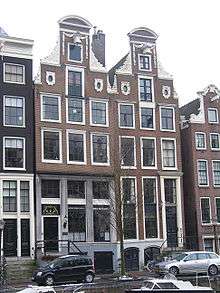Canal house

A canal house (Dutch: grachtenpand) is a (usually old) house overseeing a canal. These houses are often slim, high and deep. Because of the danger of flooding the front door is sometimes higher up and only reachable via stairs. The floor of the main storey lies about seven to nine steps above street level. Many stoops disappeared in the 19th century when entrances were moved to the basement.
Canal houses usually had a basement and a loft and attic where trade goods could be stored. A special beam or pulley installation would be located in the attic to hoist up valuable goods, like spices, cotton, or heavier stuff like cocoa. The pulleys are still used for moving furniture.
At the back of a canal house there will usually be a back garden that runs either halfway or all the way to the house behind. The garden would be laid out to the taste of the time and the financial position of the owner. At the bottom of the garden there was sometimes a summerhouse where family and visitors could relax.
In the second half of the 17th century there would sometimes be built a rear extension of the building and linked by a passage to the front house. The courtyard ensured light. It could be used for many purposes, and during World War II Anne Frank and her family were using the back house as a hiding place.
When the first owner of the house had more houses built by the same carpenter or contractor and using the same or mirrored design these are called twin or triplet houses. There are even sets of four or five identically designed houses. In those case the houses will be smaller than a normal house (as three houses were built on two land lot). The width of a canal house and the depth of its garden varies a lot. (This is because the land lots in the 17th century started from 18 Amsterdam feet (an Amsterdam foot being 28.13 cm) but then went to 20, 22, 24 and 26 feet.)
.jpg)
Along the canals in Amsterdam are also double wide houses, especially along the Herengracht. These mansions were built on two land lots, a back house was not needed. Wide houses nearly always have steps on both sides. At Herengracht 386, the museum Het Grachtenhuis (The Canal House) is located, which tells the story of the Amsterdam canal belt.
If he also bought the lots behind those houses and built a carriage house and or warehouses, it is sometimes referred to as a "city palace". Warehouses were much deeper than houses because daylight did not need to reach the centre. As trading and transport patterns changed, the warehouses lost their original function. Over the years many have been turned into living accommodation.
See also
- Anne Frank House
- Huis met de Hoofden
- Keizersgracht 453
- Museum Geelvinck-Hinlopen
- Museum Van Loon
- Museum Willet-Holthuysen
- Ons' Lieve Heer op Solder
- Trippenhuis
- 3D Print Canal House
Sources
- Building Amsterdam. (1994) Written and illustrated by Herman Janse. ISBN 90-216-7131-X
External links
-
 Media related to Canalside houses in the Netherlands at Wikimedia Commons
Media related to Canalside houses in the Netherlands at Wikimedia Commons